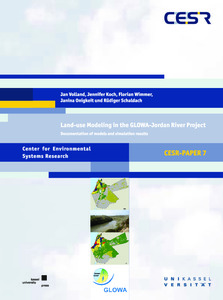Land-use modelling in the GLOWA Jordan River Project
| dc.date.accessioned | 2020-12-18T10:33:10Z | |
| dc.date.available | 2020-12-18T10:33:10Z | |
| dc.date.issued | 2014 | |
| dc.identifier | doi:10.17170/kobra-202012182713 | |
| dc.identifier.isbn | 978-3-86219-533-6 | |
| dc.identifier.uri | urn:nbn:de:0002-35338 | |
| dc.identifier.uri | http://hdl.handle.net/123456789/12267 | |
| dc.language.iso | eng | eng |
| dc.publisher | kassel university press | |
| dc.rights | Urheberrechtlich geschützt | |
| dc.rights.uri | https://rightsstatements.org/page/InC/1.0/ | |
| dc.subject.ddc | 330 | |
| dc.title | Land-use modelling in the GLOWA Jordan River Project | eng |
| dc.type | Working paper | |
| dcterms.abstract | This report presents the results from the land-use simulation study which has been carried out at the Center for Environmental Systems Research (CESR) as part of the GLOWA Jordan River project1 (sub-project 3.3.). A central objective of GLOWA Jordan River was to analyse the vulnerability of water resources in the Jordan River basin under the influence of global change. In this context the land-modelling system LandSHIFT.JR has been adapted and applied to calculate spatially explicit scenarios of land-use change on the territories of Israel, Jordan and the Palestinian Authority (PA), and the resulting impacts on ecosystem service values. The simulation results served as input for further studies within the project context, e.g. related to water availability (Menzel et al. 2009) and the GLOWA Jordan River Atlas.After an introduction, chapter 3 gives an overview of the materials and methods used to conduct the simulation study. First, the LandSHIFT.JR model is described, followed by a short introduction to the scenarios which were developed within the GLOWA Jordan River project. The quantitative model drivers that were derived from these scenarios are discussed in the last part of the chapter.In chapter 4 exemplary simulation results from LandSHIFT.JR are presented. These raster maps include information on the change of land-use types and population density as well as on livestock grazing and ecosystem service values. Starting year of the simulations was 2000 while the scenarios were specified up to the year 2050. A complete set of simulated maps is included in the annexes. | eng |
| dcterms.accessRights | open access | |
| dcterms.creator | Volland, Jan | |
| dcterms.creator | Koch, Jennifer | |
| dcterms.creator | Onigkeit, Janina | |
| dcterms.creator | Wimmer, Florian | |
| dcterms.creator | Schaldach, Rüdiger | |
| dcterms.extent | 61 Seiten | |
| dcterms.isPartOf | CESR-Paper ;; Band 7 | ger |
| dc.publisher.place | Kassel | |
| dc.subject.swd | Jordanien | ger |
| dc.subject.swd | Israel | ger |
| dc.subject.swd | Palästinensische Autonomiegebiete | ger |
| dc.subject.swd | Simulation | ger |
| dc.subject.swd | Landnutzung | ger |
| dc.subject.swd | Wasserreserve | ger |
| dc.title.subtitle | Documentation of simulation results | eng |
| dc.type.version | publishedVersion | |
| dcterms.source.series | CESR-Paper | ger |
| dcterms.source.volume | Band 7 | ger |
| kup.iskup | true | |
| kup.series | CESR-Paper | |
| kup.subject | Naturwissenschaft, Technik, Informatik, Medizin | |
| kup.typ | Monographie | |
| kup.institution | Center for Environmental Systems Research (CESR) | |
| kup.binding | Softcover | |
| kup.size | DIN A4 |
Dateien zu dieser Ressource
Das Dokument erscheint in:
-
kup - kassel university press [697]
Publikationen des Universitätsverlages Kassel


